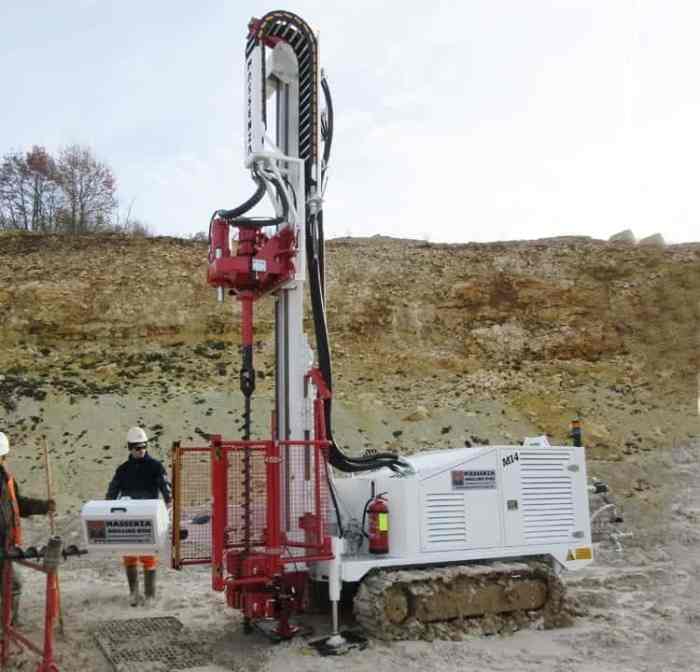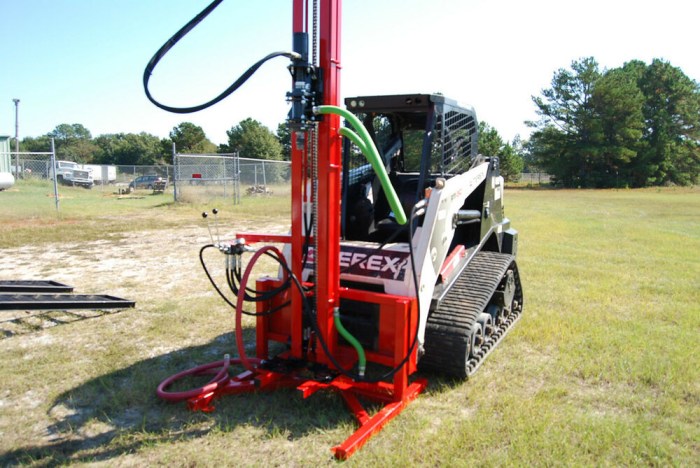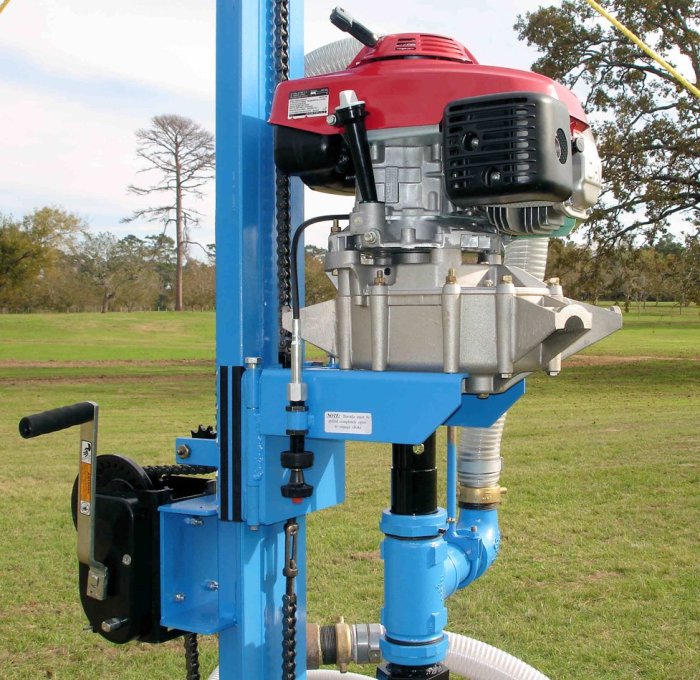DIY well drilling equipment sets the stage for this enthralling narrative, offering readers a glimpse into a world of self-reliance and resourcefulness. This guide explores the exciting and challenging world of drilling your own water well, providing a comprehensive overview of the process from start to finish.
From understanding the different types of drilling rigs and selecting the right equipment for your specific needs to mastering the techniques of drilling, installing casing, and developing the well, this guide empowers you to take control of your water supply. We’ll delve into the importance of safety, regulations, and proper water testing, ensuring that your DIY well drilling project is both successful and responsible.
Introduction to DIY Well Drilling

DIY well drilling involves the process of manually drilling a hole into the ground to access an underground source of water. This can be a cost-effective alternative to hiring a professional well drilling company, especially for individuals with the necessary skills and equipment. However, it is important to understand the risks and regulations involved before embarking on this project.
There are several advantages to drilling your own well. First, it can be significantly cheaper than hiring a professional, potentially saving you thousands of dollars. Second, it allows for greater control over the well’s location and depth, ensuring it meets your specific needs. Third, it can be a rewarding and fulfilling experience, providing a sense of accomplishment and independence. However, there are also some disadvantages to consider.
Safety Precautions and Regulations
Safety should always be a top priority when undertaking DIY well drilling projects. It is crucial to follow all relevant safety regulations and obtain the necessary permits before commencing any drilling activities. This involves understanding the local regulations governing well drilling, such as minimum setbacks from property lines and the requirement for professional inspections.
It is important to use appropriate safety gear, such as hard hats, safety glasses, and gloves. You should also be aware of potential hazards, such as cave-ins, groundwater contamination, and the risks associated with operating heavy machinery. If you are unsure about any aspect of the drilling process, it is always best to consult with a qualified professional.
DIY well drilling equipment can be a great way to save money, but it requires a lot of planning and expertise. You’ll need to consider factors like soil conditions, water table depth, and the size of your well. If you’re looking for a reliable and efficient way to cool your home, consider the mr cool diy 4th gen system.
This system is designed for DIY installation and offers excellent cooling performance. Once your well is drilled, you can ensure your home is comfortable with a properly installed air conditioning system.
- Obtain necessary permits and licenses from local authorities.
- Consult with a professional well driller or geologist to assess the feasibility of drilling a well on your property.
- Use appropriate safety gear, such as hard hats, safety glasses, and gloves.
- Follow all safety regulations and best practices.
- Be aware of potential hazards, such as cave-ins, groundwater contamination, and the risks associated with operating heavy machinery.
- Ensure the well is properly sealed and protected from contamination.
- Have the well professionally inspected and tested after drilling.
Understanding Well Drilling Equipment

Understanding the equipment used for well drilling is crucial for DIY projects, as it allows you to make informed decisions about the tools and techniques needed for your specific situation. This section will discuss the various types of drilling rigs commonly used for DIY well drilling and delve into the essential components of a well drilling rig.
Types of Drilling Rigs
Drilling rigs are the backbone of well drilling operations, providing the power and structure needed to drive the drill bit into the ground. They come in various sizes and configurations, with each type offering different capabilities and suitability for different applications.
- Hand-Operated Rigs: These rigs are the simplest and most affordable option, often used for shallow wells or for exploratory drilling. They typically consist of a tripod or A-frame structure, a winch, and a hand-operated drill stem. These rigs are well-suited for small-scale projects where the depth of the well is limited and the drilling conditions are relatively easy.
- Power-Driven Rigs: These rigs utilize a power source, such as a gasoline engine or electric motor, to drive the drill stem and provide more power for drilling deeper wells. Power-driven rigs come in various sizes, from small portable rigs to larger truck-mounted rigs. These rigs are suitable for a wider range of drilling projects, including those involving harder rock formations.
- Hydraulic Rigs: These rigs utilize hydraulic power to drive the drill stem and other functions, such as the mud pump and winch. Hydraulic rigs offer greater drilling power and control, making them suitable for drilling deeper wells and in more challenging geological conditions. They are often used for commercial and industrial well drilling projects.
Essential Components of a Well Drilling Rig
A well drilling rig consists of several essential components that work together to facilitate the drilling process.
- Drill Bit: The drill bit is the cutting edge of the drilling operation, responsible for penetrating the earth and creating the well bore. Different types of drill bits are available, each designed for specific rock formations and drilling conditions.
- Drill Pipe: The drill pipe is a long, hollow steel pipe that connects the drill bit to the drilling rig. It transmits the rotational force from the rig to the drill bit and allows drilling fluid to circulate down the hole and back up to the surface.
- Drilling Fluid: Drilling fluid, also known as mud, is a mixture of water, clay, and other additives that serves several crucial functions during drilling. It lubricates the drill bit, cools the drilling assembly, and removes rock cuttings from the well bore.
Types of Drill Bits
The choice of drill bit is crucial for successful well drilling, as different types of bits are designed for specific rock formations and drilling conditions.
- Roller Cone Bits: These bits are the most common type used for well drilling. They feature three or four cone-shaped teeth with rollers that grind and crush the rock. Roller cone bits are durable and effective in a wide range of rock formations.
- PDC Bits: Polycrystalline diamond compact (PDC) bits are highly durable and efficient bits that utilize synthetic diamonds for cutting. They are ideal for drilling through hard and abrasive rock formations, providing faster drilling speeds and longer bit life.
- Tricone Bits: These bits feature three cone-shaped teeth with steel inserts for cutting. They are commonly used for drilling through softer rock formations and are less expensive than PDC bits.
Selecting the Right Equipment: Diy Well Drilling Equipment

Choosing the right well drilling equipment is crucial for a successful and safe project. The equipment you select will depend on several factors, including the depth of the well, the soil conditions, and your budget.
Types of Drilling Rigs
The type of drilling rig you choose will have a significant impact on the overall success of your well drilling project. Here’s a table outlining the features, pros, and cons of different drilling rig options:
| Type | Features | Pros | Cons |
|---|---|---|---|
| Cable Tool Rig | Uses a heavy cable and a drill bit to break up rock and soil. | Simple design, relatively inexpensive, good for shallow wells. | Slow drilling speed, not suitable for hard rock, requires a lot of manual labor. |
| Rotary Drilling Rig | Uses a rotating drill bit and a mud system to remove cuttings. | Faster drilling speed, suitable for deeper wells and harder rock, can be automated. | More complex and expensive, requires specialized knowledge and training. |
| Air Rotary Drilling Rig | Uses compressed air to power the drill bit and remove cuttings. | Faster drilling speed, suitable for dry or unstable soil conditions, can be used in confined spaces. | Requires a large air compressor, not suitable for hard rock, can be noisy. |
Factors to Consider
When selecting well drilling equipment, consider the following factors:
- Depth of the well: The depth of the well will determine the type of drilling rig you need. Shallow wells can be drilled with a cable tool rig, while deeper wells require a rotary or air rotary drilling rig.
- Soil conditions: The type of soil or rock you will be drilling through will also influence your equipment choice. Cable tool rigs are suitable for softer soil, while rotary rigs are better for harder rock.
- Budget: The cost of drilling equipment can vary significantly. Cable tool rigs are generally less expensive than rotary rigs. You should consider the cost of the equipment, as well as the cost of operating and maintaining it.
- Experience and training: Some drilling rigs require specialized knowledge and training to operate safely and effectively. Make sure you have the necessary experience or access to qualified personnel before operating any drilling equipment.
- Safety: Always prioritize safety when drilling a well. Ensure you have the proper safety equipment and training before operating any drilling rig.
Recommendations, Diy well drilling equipment
Here are some equipment recommendations based on well depth, soil conditions, and budget:
- Shallow wells (less than 100 feet): A cable tool rig is a good option for shallow wells in soft soil conditions. These rigs are relatively inexpensive and easy to operate.
- Medium-depth wells (100-300 feet): A rotary drilling rig is a good option for medium-depth wells in a variety of soil conditions. These rigs are more expensive than cable tool rigs, but they offer faster drilling speeds and greater versatility.
- Deep wells (over 300 feet): A rotary drilling rig with a mud system is the best option for deep wells in hard rock conditions. These rigs can drill through difficult formations and provide stable wellbores.
Embarking on a DIY well drilling project is a journey that requires careful planning, dedication, and a thirst for knowledge. This guide provides a solid foundation, equipping you with the information and insights needed to navigate the challenges and reap the rewards of this endeavor. Whether you’re seeking greater independence, reducing reliance on public water systems, or simply exploring the fascinating world of well drilling, this guide is your trusted companion.
